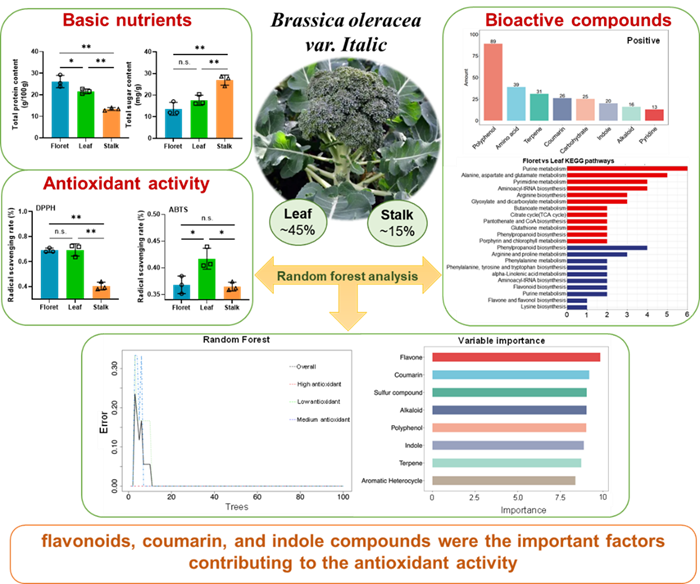Researchers from IVF-CAAS identified the metabolite compositions in the different parts of broccoli and their correlations with antioxidant activity
Recently, the Postharvest and Nutritional Group of the Institute of Vegetables and Flowers, Chinese Academy of Agricultural Sciences, identified the correlations among the metabolites of different parts of broccoli and its antioxidant activity. This study was published in Food Chemistry (IF="8.8)," entitled "A comparative metabolomics analysis of phytochemicals and antioxidant activity between broccoli floret and by-products (leaves and stalks)".

The high-value utilization of horticultural product waste is one of the important ways to reduce food waste and utilize the existing green resources. Broccoli is a high-quality vegetable which is in rich of bioactive compounds and have been widely preferred by the customers. The planting area in China has been exceeded 1.5 million acres, and the production amount is more than 2 million tons. However, in addition to edible floret, stalks and leaves account for more than 60% of the total biomass, which are considered as food waste. These broccoli wastes not only cause environmental pollution, but also limit the sustainable and healthy development of the industry. Accordingly, this study aimed to identify the composition and differences of phytochemicals in different parts of broccoli using non-targeted metabolomics. Moreover, the random forest model and correlation analysis was used to analyze the structure-activity relationship among the metabolites and antioxidant activity of different parts of broccoli (Figure 1). Together, these results will provide a theoretical basis and data support for the future extraction and preparation of functional active substances based on broccoli waste to create of functional new products.

Figure 1 Metabolites in the different parts of broccoli and the correlations with antioxidant activity.
The first author is the PhD candidate Zhao Yaqi in the Postharvest and Nutritional Group of the Institute of Vegetables and Flowers, Chinese Academy of Agricultural Sciences. Professor Deng Jianjun and Assistant Researcher Zhang Wenyuan are the co-corresponding authors. This research was funded by the Innovation Engineering Project of the Chinese Academy of Agricultural Sciences and the Basic Research Funds Coordination Project of the Chinese Academy of Agricultural Sciences.
Link to this paper: https://doi.org/10.1016/j.foodchem.2024.138517
By Wenyuan Zhang (zhangwenyuan@caas.cn)
-
 Apr 18, 2024Opening Ceremony of the Training Workshop on Wheat Head Scab Resistance Breeding and Pest Control in Africa Held in CAAS
Apr 18, 2024Opening Ceremony of the Training Workshop on Wheat Head Scab Resistance Breeding and Pest Control in Africa Held in CAAS -
 Apr 03, 2024IPPCAAS Co-organized the Training Workshop on Management and Application of Biopesticides in Nepal
Apr 03, 2024IPPCAAS Co-organized the Training Workshop on Management and Application of Biopesticides in Nepal -
 Mar 28, 2024Delegation from the School of Agriculture and Food Science of University College Dublin, Ireland Visit to IAS, CAAS
Mar 28, 2024Delegation from the School of Agriculture and Food Science of University College Dublin, Ireland Visit to IAS, CAAS -
 Mar 25, 2024Director of World Food Prize Foundation visited GSCAAS
Mar 25, 2024Director of World Food Prize Foundation visited GSCAAS -
 Mar 20, 2024Institute of Crop Sciences (ICS) and Syngenta Group Global Seeds Advance Collaborative Research in the Seed Industry
Mar 20, 2024Institute of Crop Sciences (ICS) and Syngenta Group Global Seeds Advance Collaborative Research in the Seed Industry
